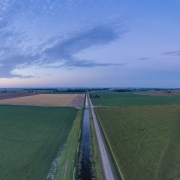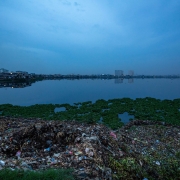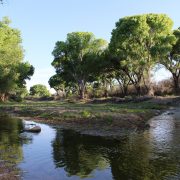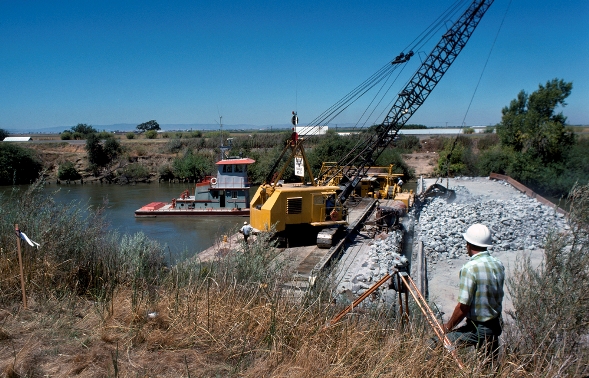Des Moines River ‘Essentially Unusable’ for Drinking Water due to Algae Toxins
Levels of microcystin in the river have recently been measured more than 10 times higher than the federal recommendation for drinking water.

The Des Moines River runs through Iowa’s capital city and is one of its drinking water sources. Photo courtesy of Flickr Creative Commons user Ty Nigh
By Perry Beeman, Iowa Capital Dispatch
August 26, 2020
The Des Moines River is “essentially unusable” as a drinking water source for 500,000 central Iowans because of toxins from algae, leaders of the Des Moines Water Works said Wednesday.
Des Moines River levels of a toxin that comes from blue-green algae, microcystin, have recently been more than 10 times the federal recommendation for drinking water, said Laura Sarcone, Water Works spokeswoman. The river is one of the two largest sources of water treated to provide tap water.
“The Des Moines River is essentially unusable” due to the hassle and expense of added treatment that would be needed to ensure the toxins were removed, Sarcone said.
Blue-green algae fed by fertilizer runoff and manure are the main source of the toxins, which can cause skin rashes, intestinal problems, and in severe cases, liver damage. The foul-smelling toxins can quickly kill dogs and other animals that drink the contaminated water.
Levels vary by the day and have run high for weeks, but have spiked the past couple of summers in the Des Moines River.
The federal health advisory level for water treated to supply taps is far stricter than for swimming. The toxin level in the Des Moines River is well within standards for recreational contact in Des Moines, where community leaders are planning a multi-million-dollar development for whitewater kayaking.
Ted Corrigan, Water Works CEO and general manager, said the utility is discussing a new shallow-well installation along the Des Moines River north of Interstate Highway 235 and south of Interstate Highway 80. The facility would cost “tens of millions of dollars” — meaning higher water bills for residents and businesses — but would help the utility sidestep both the algae toxin problem and nitrate issues related to farm runoff, Corrigan said.
Extended exposure to high concentrations of nitrates has been associated with a condition that suffocates infants and with a variety of cancers.
Corrigan said Water Works has been using water from the Raccoon River, the utility’s other main source of untreated water, to avoid the toxins in the Des Moines River.
“It’s a challenging problem for us,” Corrigan said. “We are starting to see microcystin in the Des Moines River on an annual basis.”
Corrigan suspects the blue-green algae, known as cyanobacteria, that emit the toxins are forming at Saylorville Lake. That is an U.S. Army Corps of Engineers flood-control reservoir north of Des Moines that doubles as water storage for the utility and empties into the Des Moines River.
Des Moines is one of many U.S. cities fighting the health threat.
A new report from the Environmental Working Group Wednesday found that U.S. communities where algae toxin outbreaks had been reported spent more than $1.1 billion on prevention and treatment of the toxins over the past decade. In Iowa, that figure was $40.6 million, for six locations.
The nonprofit environmental organization studied 85 locations in 22 states based on news coverage of outbreaks. The report notes the problem goes far beyond the incidents included in the report.
“This enormous sum is just a drop in the bucket of what algae outbreaks are costing Americans,” Anne Schechinger, a senior economic analyst and author of the report, said in a statement. “The damage toxic algae inflicts on recreation, property values, tourism, commercial fishing and wildlife likely totals billions more every year.”
Last year, the Florida Phoenix reported about a controversy over a multi-billion-dollar reservoir plan to address the issue in the Everglades, where some supported using wetlands instead.
The cost of improvements to drinking water, storm water and wastewater systems made up most of the expenditures, Environmental Working Group reported. Changes in farm practices made up much of the rest.
Spending in Ohio accounted for about 70% of the nationwide total. More than $815 million has been spent in 11 Ohio communities since 2010, largely for multiple recurring toxic algae blooms in Lake Erie.
The Ohio spending was an indication the state was taking the problem seriously, Schechinger said. “If other communities were proactively tackling their algae problems the way Ohio is, the total cost of treatment and prevention would be larger throughout the country,” she said.
Environmental Working Group has found more than 1,000 communities in 49 states with news reports of algae blooms since 2010
The Environmental Working Group’s map shows a couple of dozen incidents in Iowa. However, the Iowa Department of Natural Resources regularly monitors state park beaches for the toxin.
State records show that the only state park beach with a current warning for microcystin is Union Grove State Park near Gladbrook in Tama County. However, the most recent tests at the park found levels eight times the state’s newly tightened health standards for the toxin.
The state had 21 microcystin warnings last year, but would have had 14 more under the more restrictive standard. The Iowa Department of Natural Resources had residented the lower limit — less than half the previous state standard — but changed under pressure from the environmental council and others to adopt the U.S. Environmental Protection Agency’s new recommendation.
The week of July 10 George Wyth State Park, Lake of Three Fires State Park near Bedford, and Union Grove, which is near Gladbook, all had microcystin warnings. Lake of Three Fires also had warnings for the weeks of June 5 and May 29.
The nonprofit Iowa Environmental Council called the Environmental Working Group analysis “eye-opening,” but noted the report only touched on part of the problem.
“The calculated costs in their report include only six locations in Iowa,” said Alicia Vasto, the council’s water policy and advocacy specialist. “We know toxic algae blooms are widespread in our state and incur other personal costs and loss of income to small businesses that rely on lake tourism.
“Again the solution to the ever-rising costs of pollution is prevention – prevent farm chemicals from reaching our waters, and reduce everyone’s costs in the long-run,” Vasto added.
The costs of dealing with the toxins can be particularly heavy in small markets, the council noted.
“Increased drinking water treatment expenses fall more heavily on small communities,” Vasto said. “Public water systems in rural Iowa are struggling to keep costs down for customers while still providing clean, safe drinking water.
“These problems will continue to get worse until our state leadership regulates agricultural pollution entering our waters and seriously invests in water quality protection in Iowa,” Vasto added.
Scientists have struggled to determine exactly what conditions make the algae produce the toxins. Studies have shown hot, stagnant conditions and heavy runoff seem to be associated.
The number of microcystin advisories have varied from one to 37 since weekly summertime testing started at state park beaches in 2006.
Iowa Capital Dispatch is part of States Newsroom, a network of news bureaus supported by grants and a coalition of donors as a 501c(3) public charity. Iowa Capital Dispatch maintains editorial independence. Contact Editor Kathie Obradovich for questions: info@iowacapitaldispatch.com. Follow Iowa Capital Dispatch on Facebook and Twitter.










Leave a Reply
Want to join the discussion?Feel free to contribute!